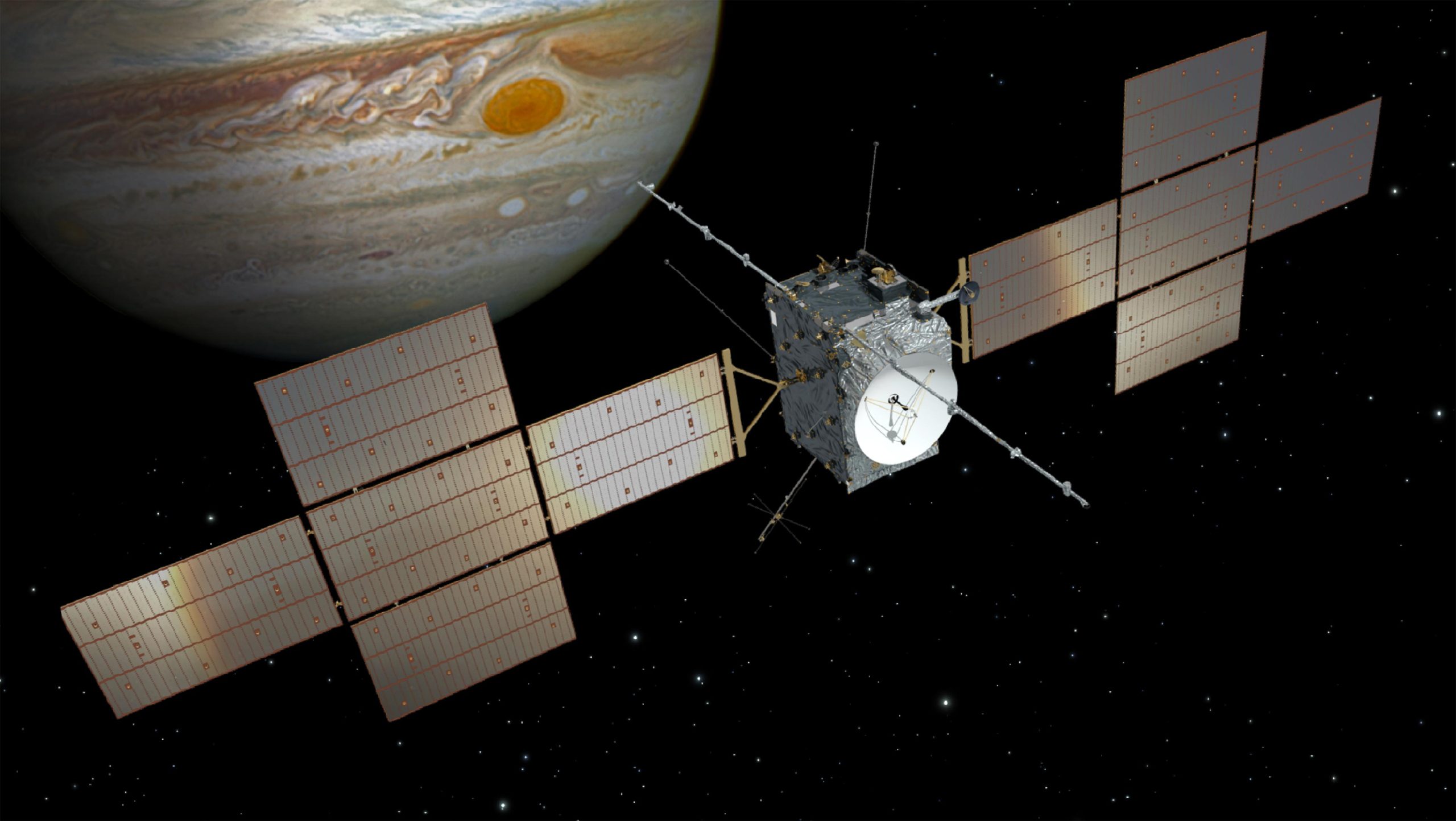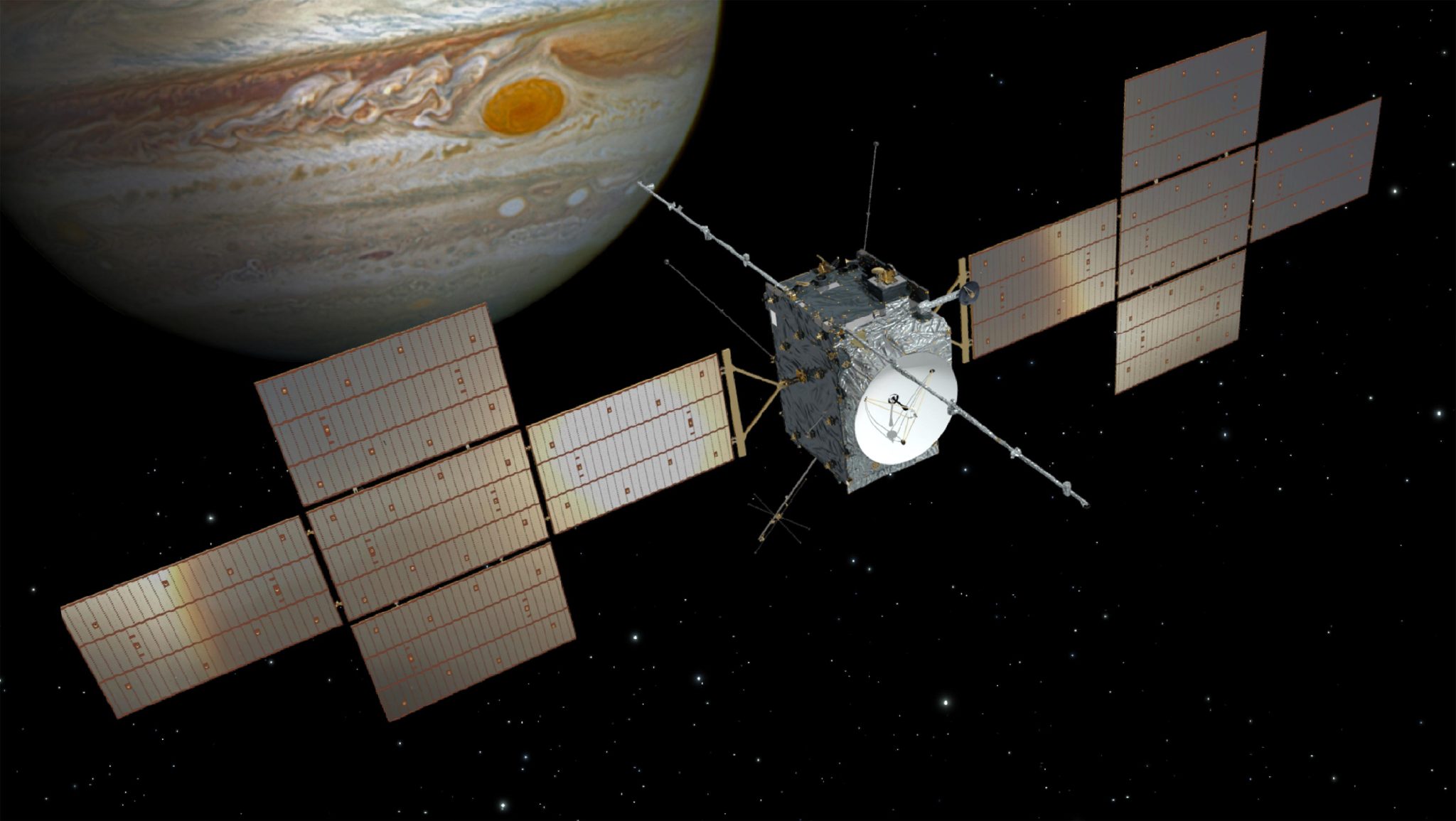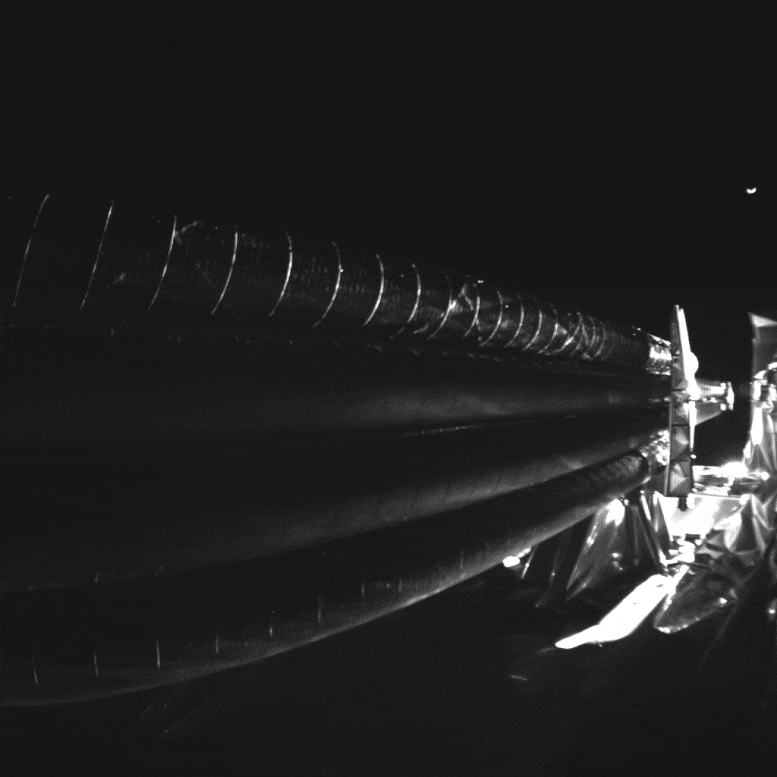

Ilustrație a navei spațiale JUICE de la Jupiter. Antena Radar pentru Icy Moons Exploration (RIME) de pe nava spațială Jupiter Icy Moons Explorer (Juice) a Agenției Spațiale Europene a întâmpinat o problemă care împiedică propagarea acesteia. Antena de 16 metri, care este crucială pentru studiul suprafeței și structurii subterane a lunilor înghețate ale lui Jupiter, este în prezent blocată în suportul său de montare din cauza unui suspect mic știft. În ciuda eșecului, antena dă semne de mișcare și este parțial extinsă. Credit: ESA
ESA[{” attribute=””>Jupiter Icy Moons Explorer (Juice) has encountered a deployment issue with its Radar for Icy Moons Exploration (RIME) antenna. The issue, potentially caused by a stuck pin, is being addressed by ESA’s mission control teams with various strategies, including an engine burn and spacecraft rotations. Despite this, Juice’s other instruments are functioning properly, and there’s a two-month window to solve the problem.
Juice’s ice-penetrating RIME antenna has not yet been deployed as planned. During the first week of commissioning, an issue arose with the 16-meter-long Radar for Icy Moons Exploration (RIME) antenna, which is preventing it from being released from its mounting bracket. Juice is currently 3.5 million km (2.2 million miles) from Earth.
Work continues to free the radar and teams at ESA’s mission control center in Darmstadt, Germany, along with partners in science and industry, have lots of ideas up their sleeves.
Every day the RIME antenna shows more signs of movement, visible in images from the Juice Monitoring Camera on board the spacecraft with a partial view of the radar and its mount. Now partially extended but still stowed away, the radar is roughly a third of its full intended length.

Juice’s stuck but moving RIME antenna is captured by the Juice Monitoring Camera on board the spacecraft. This animation shows the radar’s movements in five photos taken across April 17–21, as teams on Earth work through steps in Juice’s deployment. Four segments of the RIME antenna are visible here, folded on top of each other. This ‘stack’ of antenna elements is one half of the full antenna, next to the other half also in a folded stack. The other half has not yet begun deployment and becomes visible through the widening gaps between antenna segments. Credit: ESA/Juice/JMC, CC BY-SA 3.0 IGO
The current leading hypothesis is that a tiny stuck pin has not yet made way for the antenna’s release. In this case, it is thought that just a matter of millimeters could make the difference to set the rest of the radar free.
Various options are still available to nudge the important instrument out of its current position. The next steps to fully deploy the antenna include an engine burn to shake the spacecraft a little followed by a series of rotations that will turn Juice, warming up the mount and radar, which are currently in the cold shadows.

Shortly after launch on April 14 , ESA’s Jupiter Icy Moons Explorer, Juice, captured this image with its Juice monitoring camera 2 (JMC2). JMC2 is located on the top of the spacecraft and is placed to monitor the multi-stage deployment of the 16 m-long Radar for Icy Moons Exploration (RIME) antenna. RIME is an ice-penetrating radar that will be used to remotely probe the subsurface structure of the large moons of Jupiter. In this image, RIME is seen in stowed configuration. Credit: ESA/Juice/JCAM, CC BY-SA 3.0 IGO
Juice is otherwise performing excellently after the successful deployment and operation of its mission-critical solar arrays and medium gain antenna, as well as its 10.6-m magnetometer boom.
With two months of planned commissioning remaining, there is plenty of time for teams to get to the bottom of the RIME deployment issue and continue work on the rest of the powerful suite of instruments on their way to investigate the outer Solar System.

A 1:18 scale model of the Juice mission’s RIME antenna – Radar for Icy Moons Exploration, mounted on top of a simplified spacecraft model during tests in the Hertz facility at the European Space Research and Technology Centre (ESTEC) in Noordwijk, The Netherlands. RIME is an ice-penetrating radar that will be used to remotely probe the subsurface structure of the large moons of Jupiter. Emitted by a 16-m long dipole antenna, the radar signals will penetrate the icy surfaces of the moons down to a depth of 9 km, providing a vertical resolution between 50 and 140 m. Credit: ESA–M.Cowan, CC BY-SA 3.0 IGO
Updates will be shared as new information becomes available.
The RIME instrument is an ice-penetrating radar designed to study the surface and subsurface structure of Jupiter’s icy moons down to a depth of 9 km.
It is one of ten instruments on board ESA’s Jupiter Icy Moons Explorer, Juice, set to investigate the emergence of habitable worlds around gas giants and the formation of our Solar System.

„Mândru pasionat al rețelelor sociale. Savant web fără scuze. Guru al internetului. Pasionat de muzică de-o viață. Specialist în călătorii.”





More Stories
Simulările pe supercomputer dezvăluie natura turbulenței în discurile de acumulare a găurilor negre
Trăiește cu anxietate: sfaturi de specialitate despre cum să accepti o afecțiune de sănătate mintală
Noile cercetări asupra unei falii masive de tracțiune sugerează că următorul cutremur mare ar putea fi iminent